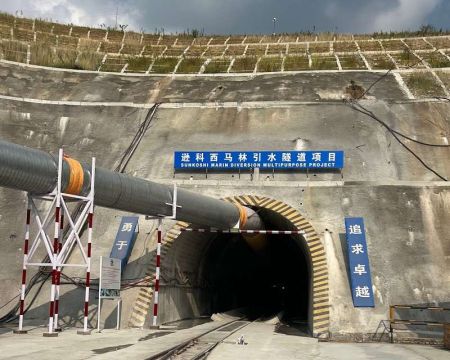After spending three and a half decades in the government banking sector, notably with Nepal Bank Limited and Rastriya Banijya Bank Limited (RBBL), Kiran Kumar Shrestha, the CEO of RBBL, is nearing the end of his illustrious banking career. Serving two tenures as CEO of RBBL over the past eight years, Shrestha has overseen a remarkable transformation of the state-owned bank, propelling it to the forefront of Nepal's commercial banking landscape with impressive profit growth. RBBL has undergone a significant turnaround since the challenges it faced in the 2000s which necessitated government intervention and support from entities such as the World Bank for its revival. Under Shrestha's leadership, the bank has strategically focused on business expansion, notably through initiatives aimed at expanding its branch network and recruiting top talent. In an interview with Mukul Humagain, Shrestha talked about his major works at RBBL, current strategic priorities, and the prevailing challenges within the banking sector. Excerpts:
The robustness of Nepal's banking system has recently come into question by some people who are calling to defy loan payments. As the CEO of a leading commercial bank, how would you assess the strength and resilience of the Nepali banking system?
Nepali commercial banks are safe, reliable, and well-operated institutions. Several factors support this assertion. The banking system is rigorously supervised and regulated by the central bank, with all banks fully adhering to regulatory guidelines. Nepali banks demonstrate commitment to risk management and compliance, including anti-money laundering (AML) measures, in line with international standards. Robust systems and processes are in place, including banks' internal controls and external audits, including those conducted by the central bank. Banks have also maintained high standards when it comes to loans. While non-performing loans (NPL) levels have gone up recently, the NPL ratio of Nepali banks is lower compared to other South Asian countries.
Banks are institutions that prioritise transparency in their operations. They release financial statements on a quarterly, half-yearly, and annual basis. The level of disclosure within the banking system surpasses that of many other institutions. Information such as interest rates on loans or deposits is readily available for anyone to access and evaluate. Additionally, depositors' security is ensured through the deposit insurance mechanism, offering coverage up to Rs 5,00,000 per individual per institution. With these measures in place, I can confidently affirm that our banking system is secure and reliable. The rumours about the banking system lack substance and are not grounded in facts or figures.
What factors are responsible for the decline in profitability as indicated in the second-quarter reports of commercial banks including RBBL?
Two or three significant factors are contributing to this situation. First, commercial banks currently maintain a comfortable liquidity position and a favourable Credit-Deposit (CD) ratio. A healthy CD ratio, indicating more deposits relative to credit, is conducive to stability. However, the anticipated credit growth of 12% fell short and stayed below 5%. This means low interest income for banks. On the other hand, while the influx of deposits is advantageous for deposit mobilisation, it increases interest expenses for banks which hit their profit margins. Another concerning trend is the increase in Non-Performing Loans (NPLs). Until recently, the industry's NPLs averaged below 2%. Now it has gone above 3% percent with some banks reporting NPL at 4%. This overall surge in NPLs necessitates compliance with provisioning requirements mandated by the central bank which impacts profits. Concurrently, escalating NPLs and other fixed expenses further strain profitability leading to a decline compared to the previous fiscal year. This decline is also mirrored in the profit downturn experienced by us.
It is essential to understand that interest rate is not determined solely by the preferences of banks. Rather, it adheres to the principles of market demand and supply.
Given the lacklustre performance of banks over the first half of the current fiscal year, what are your projections for their performance in the second half?
The fate of banking institutions is tied to the broader economic landscape. The ongoing economic downturn has cast uncertainty over the banking sector. This means the projections for the remainder of the financial year hinge on the trajectory of the economic recovery. While banks play an important role in stimulating economic activity, their prosperity is contingent upon the overall health of the economy. The sluggish rate of capital expenditure has dampened prospects for robust growth in the banking industry. However, recent assessments by both the Ministry of Finance and the Nepal Rastra Bank (NRB) show improvements in key economic indicators. From a comfortable balance of payments to stable remittance inflows and healthy foreign exchange reserves, the external sector exhibits resilience in the face of prevailing challenges. However, the sustained progress hinges on increased capital expenditure and timely disbursement of government payments. Unlocking these funds would create a ripple effect, revitalising backward and forward linkages within the economy. The third and fourth quarters hold promise for incremental improvement. Bridging the gap compared to previous years presents a formidable challenge. Nevertheless, proactive measures to stimulate economic activity and expedite capital expenditure could yield favourable outcomes for the banking sector in the coming months.
Although banks have reduced interest rates for loans, credit flow went up by only 4.5% in the first half. What do you think are the reasons for slow credit growth?
Interest rates on deposits surged to double digits in the last fiscal year primarily due to a scarcity of deposits within the banking system. Intense competition among banks to attract deposits further exacerbated this situation. Consequently, banks were compelled to raise deposit interest rates which subsequently pushed lending rates higher. It is essential to understand that interest rate is not determined solely by the preferences of banks. Rather, it adheres to the principles of market demand and supply. While high interest rates can impact the demand for loans, other factors such as electricity, labour costs, raw material expenses, rent and imported goods from the international market all play pivotal roles in business operations. Interest rates represent just one aspect of the broader business landscape.
The demand for loans does not pick up automatically when interest rates are lowered. It is contingent upon the full operation of economic activities as well as the business environment. As economic activities expand, so does the demand for credit. During a recession, the private sector tends to adopt a cautious ‘wait-and-see’ approach which can further dampen loan demand.
Which sectors have witnessed a decline in demand for loans this fiscal year?
The cement and steel industries are operating at only 30-40% of their capacity. This slowdown has also impacted sectors directly linked to construction, such as housing and infrastructure development. The demand for loans in these sectors will not pick up until infrastructure projects gain momentum. Additionally, hotels and resorts, significantly affected by the COVID-19 pandemic, are striving for recovery but have yet to return to full operation. Similarly, assembly sectors face similar challenges with limited capacity to take on additional loan burdens while undergoing restructuring to meet existing loan payments.
It is crucial to understand that the loans disbursed by banks are sourced from deposits which belong to the common people. In any bank, the deposits collected from the general public outweigh the investments of owners or investors.
Recently, there has been a noticeable increase in property auction notices published by banks. Has loan recovery emerged as the most significant challenge for banks?
If we study the current challenges based on numbers, it is evident that loan recovery has become the primary concern. The repercussions of delayed loan recovery are substantial. Moreover, additional provisioning becomes necessary in such cases. Failure to address Non-Performing Loans (NPLs) promptly may lead to prompt corrective action being taken against banks which adversely affect their international reputation.
In the current scenario, banks are encountering certain obstacles in executing the rights and procedures necessary for loan recovery. Notably, the confidence of the private sector has declined. It is crucial to understand that the loans disbursed by banks are sourced from deposits which belong to the common people. In any bank, the deposits collected from the general public outweigh the investments of owners or investors. For instance, RBBL has Rs 350 billion in deposits compared to Rs 200 billion in loans. The bank's own capital amounts to only around Rs 16-17 billion with the remainder being the common people’s deposits. This principle applies to other banks as well. Therefore, loan recovery is essential not only for the financial health of the banks but also for safeguarding the depositor's funds. Hence, the recovery of Non-Performing Loans (NPLs) has now become a primary focus for banks.
Considering the significant loan exposure of banks to the microfinance and cooperative sectors, do you anticipate that the challenges observed in these sectors will affect commercial banks as well?
While banks themselves may not be facing similar challenges as cooperatives, there is a prevailing psychological atmosphere that appears to instil some reluctance to pursue loan recovery activities with full confidence. Banks typically invest in thoroughly analysed projects, where all aspects, from financial viability to management competence and collateral evaluation, are meticulously assessed. Hence, banks are not likely to encounter the same issues as those currently faced by cooperatives. However, there has been a delay in expediting the loan recovery process as efficiently as desired.
It appears that the financial statements of banks that have undergone mergers are not satisfactory. Are we not witnessing the anticipated synergy effects resulting from these mergers?
Although RBBL is not involved in any merger, I have consistently advocated for mergers as a positive force emphasising the creation of synergies and increased capacity when banks consolidate. Such expansions are generally seen as beneficial to the national economy. Despite these potential benefits, the recent balance sheet assessments of merged banks have not reflected the anticipated impact of the mergers. However, drawing definitive conclusions about the success of mergers at this stage may be premature. Firstly, many of these mergers are still in their first year. Additionally, the merging entities often possess distinct work cultures and backgrounds which can complicate integration efforts. While the technical aspects of a merger can be meticulously arranged, the psychological adjustments necessary to foster true synergy take time. One notable challenge is the turnover of employees which can disrupt operations and even affect credit recovery processes if departing employees take critical knowledge with them.
As you draw curtains on your banking career, how do you reflect on the transformation witnessed within RBBL during your tenure?
I evaluate its progress through both financial and non-financial lenses. Financially, the bank has demonstrated substantial growth across various metrics including capital, deposits, credit, profits and reserve surplus. When I assumed leadership at RBBL, the loan portfolio was at a modest Rs 85 billion. Today, it has expanded to Rs 255 billion. Notably, the bank consistently achieved profits above Rs 2 billion with profits in two consecutive years exceeding Rs 5 billion. Additionally, RBBL has transitioned from being unable to distribute dividends to boasting a positive net worth exceeding Rs 50 billion.
On the non-financial front, RBBL faced the challenge of reshaping public perception as a government-owned entity, often viewed as inferior to private sector peers in terms of service quality and profitability. I initiated a strategic overhaul to address this challenge. I brought in nearly 2,000 fresh talents. This infusion of new energy revitalised the RBBL's workforce. Concurrently, initiatives such as the "Clean and Smart RBBL" campaigns were launched to enhance the bank's reputation and service standards. Furthermore, comprehensive system upgrades were undertaken and we modernised policies and procedures to align with industry best practices. Extensive training programs were implemented to equip employees with the necessary skills and knowledge. As a result of these concerted efforts, RBBL has evolved into a dynamic and competitive institution.
What are the benefits and drawbacks of serving as the CEO of a government-owned bank?
Working as the CEO of a government-owned bank offers certain advantages such as the trust and confidence that the public places in government institutions. This trust makes it easier to attract deposits and lend money, as people perceive government banks as stable and not solely profit-driven. However, there are also challenges associated with operating within the government banking sector. Despite competition within the banking industry, government banks must navigate bureaucratic processes and adhere to government regulations which can hinder agility and quick decision-making. For example, RBBL has to follow the lengthy procedures associated with hiring as the government recruitment is managed by the Public Service Commission. However, candidates selected through this process tend to be highly skilled which helps compensate for the time constraints. Similarly, adhering to the government procurement process often leads to litigation, causing delays in resolving issues that significantly impact service delivery. Unlike private enterprises, RBBL cannot always act solely based on its own discretion. Despite these constraints affecting service delivery, RBBL remains competitive by effectively managing these challenges.
Government banks should prioritise services tailored to small and medium-sized enterprises (SMEs) and rural areas aligning with governmental priorities in agriculture, tourism, hydropower, and SMEs.
Are government banks essential for Nepal?
Government banks play a crucial role in Nepali economy, as they are instrumental in implementing government policy programs and priorities. However, the specific structure and number of government banks could be a matter of discussion. The recent merger discussions have highlighted the importance of capital adequacy for expanding lending capacity. The government priorities may pose challenges in allocating capital to banks, especially when considering investments in other sectors. In such scenarios, alternatives such as mergers among government banks might emerge. Moving forward, government banks should prioritise services tailored to small and medium-sized enterprises (SMEs) and rural areas aligning with governmental priorities in agriculture, tourism, hydropower, and SMEs. Nepal Rastra Bank has also already emphasised these sectors. Considering the geographic spread and accessibility challenges, particularly in remote areas where reaching a bank might take days, efforts should be made to address these gaps.
Furthermore, embracing digitisation is crucial for government banks to remain relevant and competitive in the evolving financial landscape. The digital banking system represents the future of banking, offering enhanced efficiency and accessibility to customers. Embracing digitisation will ensure government banks remain at the forefront of innovation and meet the evolving needs of customers in Nepal.






















